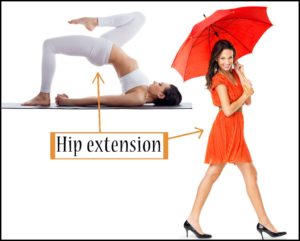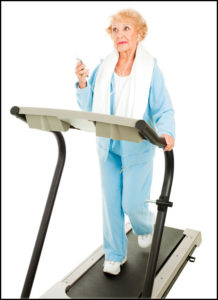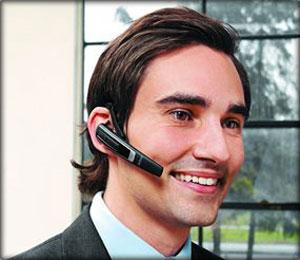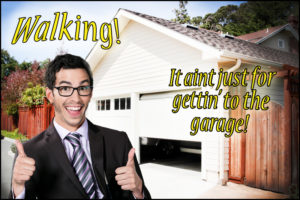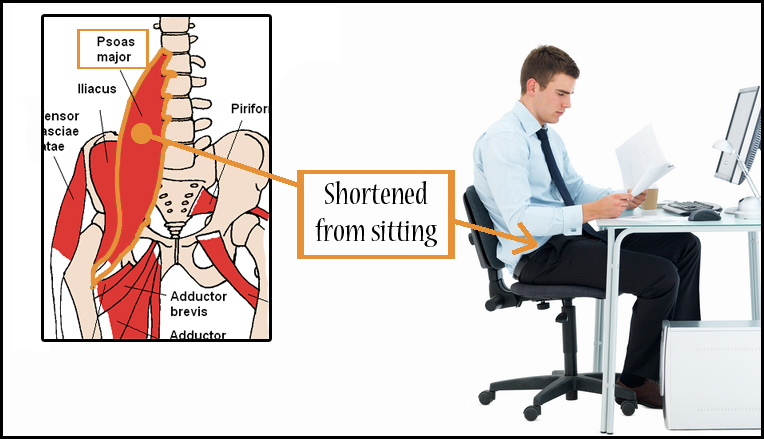
Bob sat all day. He sat at breakfast, in the car, in his cubicle, at lunch, and on the toilet. Then he drove to the gym where he sat on the leg press, chest press, and the bike. Now he’s home sitting on the couch wondering why his back hurts (1). Kudos to Bob for exercising, but does he know we evolved to walk upright?
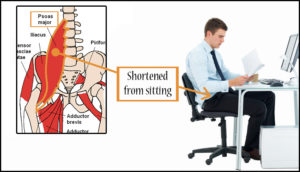 |
| 9 hours of tightening |
Walking is the best possible exercise.Thomas Jefferson
Resolutions to start exercising are often scuttled by confusion. Where to begin? Is yoga good? Should I start jogging? Whatever your goals, whatever your level of fitness, walk first. Before stressing over the details of a complex training program, just start moving. If you’re intimidated by kettlebells, jump ropes, bowflex, and Zumba, just step outside. Once you’re doing it regularly, then you can, and should, add weights and cardio.
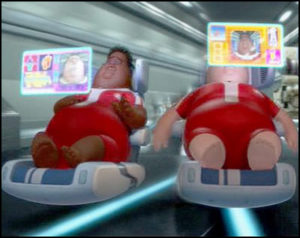 |
| The not so distant future |
Walking is foundational. It builds basic strength, stamina, and core stability, which you’ll need before anything else gets thrown on top.
Up to 80% of adults will experience back pain in their lifetime (27). Research suggests they may just need to train their glutes.
Bob should definitely be lifting weights. But after sitting all day, muscle creep has set in (2). His hip flexors (upper thigh) and hamstrings have tightened, while his quads and butt muscles are overstretched (gluteal amnesia) (3). A recent study compared glute activity between two groups of adult men; a healthy group, and a low back pain group. The study revealed that walking at an incline produced much greater glute activation in the healthy group (20). The low back pain sufferers weren’t using their butts, resulting in too much lumbar stress. Psoas tightness could have been a factor, as well as disuse of the gluteals. Inactivity (constant sitting) can lead to atrophy of the hip musculature (21). So even if Bob goes to the gym, his butt is like me on vacation: stretched out and in no mood to work. His back woes could be the result of substituting lumbar extension for hip extension, hinging in the lower back instead of the hip.
Though not the main locomotors, the glutes fire with every step, primarily in the stance phase (23). And they work disproportionally harder the faster you go (24). Find an incline, and they’ll work harder still. As they contract, the antagonist hip flexors lengthen. Finally we’re starting to offset the imbalances caused by sitting. But that’s assuming form is correct. Walk tall, and lead with the hips. Actively extend the back leg. Put your hands on your butt to feel if it tightens as you push off, but remove them if you visit in-laws.
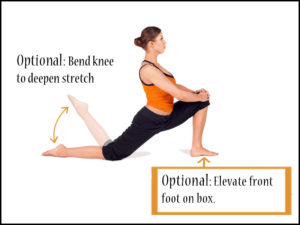 |
| Low lunge stretch |
If your hips feel tight, or your pelvis is tucked under, this stretch may help. Lift the chest and push the hips forward. If you don’t feel much in the rear upper thigh, or if it bothers your lower back, try elevating the front foot. You can further increase the stretch by bending the back knee and resting the foot on something.
In a nutshell:
You sit all day, which loosens and weakens the glutes, which are overpowered by tighter hip flexors, possibly leading to pancake butt and lower back pain. Walking, thigh stretching, and bridging might fix it.
Weight training and cardio are catabolic activities. They deplete energy stores, damage muscle, and punish the nervous system. Assuming sufficient recovery and nutrition, these are all good things, until they’re not. That threshold is different for everyone, but the warning signs are consistent: chronic fatigue, insatiable appetite, joint pain, inflammation, and plateaued fat loss or muscle gain.
|
WALKING Burns mainly fat
Easy on the body
Long duration Fast recovery Spares muscle Conducive to high frequency Limited effect on appetite Lowers stress hormones Very safe
|
SPINNING Burns mainly glucose
Hard on the body
Short duration Slow recovery Breaks down muscle Inconducive to high frequency May stimulate appetite (16) Elevates stress hormones (14) Greater likelihood of overuse injury (13) |
Long story short: spinning may lead to overtraining and overeating, but you can sustainably walk all day, all week, increasing fat metabolism, without substantially stoking your hunger or hurting yourself.
Elite bodybuilders understand this. Its why they do an hour of light cardio (easy cycling, walking) almost daily, and frequently fasted (early AM). They gently, patiently, and consistently cook off fat stores with easy aerobic exercise.
Building muscle and burning fat requires ideal conditions. Your body is neurotic and fragile, always planning for the worst. Overstress it daily, and it will respond by hoarding fat, breaking down muscle for fuel, and speeding the aging process. It is very easy to train too much. It is nigh on impossible to walk too much.
Another quirk of the active group is they tend to launch directly into physical activity the moment they enter the gym. My advice, especially considering they probably drove there, is to walk for five minutes.
Real walking requires active hip extension; pushing off the ground to propel your body. But the treadmill only asks you to swing your leg forward in time to land on the belt, which then carries it back for you. Studies have shown treadmill walking produces faster cadence, diminished stride length, and a shorter stance phase, suggesting less recruitment of the glutes and hamstrings (4,5,6). Arm swing is impacted, which may negate some of walking’s upper body benefits.
And on a personal note, I loathe the notion of negated work. You expend just enough energy to nullify that of the treadmill. It’s digging a ditch while someone fills it in. It’s absurd! Call me a luddite or tree hugger, but what a waste of electricity. What does it say about us when even walking must be motorized?
HOWEVER! There are obvious restrictions to outdoor walking. In our car-centric culture, sidewalks are becoming obsolete. And rain can short out your iPhone. So by all means, if nature is unavailable, the treadmill beats the couch.
I know. Try this stuff.
- Get a bluetooth headset and make your calls on foot. You’ll look like a schmuck, but you’ll be healthier.
- Try podcasts, lectures, or audiobooks. If nature can’t provide enough stimulation, perhaps the dulcet voice of David Mcullough would help.
- Park far. From work, the store, whatever. If you live in a city, perhaps you could walk to work, unless that city is Baghdad.
- Get a dog.
- Get a standing desk.
- Travel. Take walking tours. Hike. Visit neighbors. It all adds up.
- Call customer service on your headset. That guarantees hours of exercise, and the endorphins may mitigate homicidal urges.
- Quit your desk job and juuuuuust kidding, I’m not that far gone.
- Ditch the cart and walk the golf course, if they’ll let you.
- Try a pedometer. Cheaper is fine, unless you want bells and whistles.
- Perhaps an app. Android or iPhone tracking data might spur you on.
 |
| Walkin is good for you |
- Ward off dementia.
- Spinal therapy. Although studies have shown mixed results (26), there is some evidence that walking may be a beneficial treatment for chronic low back pain. The inconclusive results could be due to poor coaching or compliance, or the paucity of data. Hypothetically, the gentle rotational loads induced by walking may provide adequate stimulation for the core musculature.
- You’ll really work your calves. Distal muscles are activated the most (10).
- The hamstrings are involved in propulsion but work harder to decelerate your leg as it swings forward (9). Athletes should consider this when training for injury reduction.
- Cook off some of your dinner. Postprandial walks lower triglycerides (11).
- Walking may have a positive effect on bone density, but should not be relied on alone to combat osteoporosis (8). Regular weightlifting and adequate nutrition are recommended.
- Improve insulin sensitivity (12).
- Postmenopausal women can substantially decrease chances of cardiovascular events (25).
- Older adults with diabetes can decrease chances of mortality from cardiovascular disease (18).
- Good for brainstorming, or cooling off after a fight.
All truly great thoughts are conceived while walking.Friedrich Wilhelm Nietzche
- Walk tall. Lead with the hips, lift your chest.
- You want some firmness in your midsection, but looseness in the upper spine and shoulders.
- Speed up a bit. “Mall strolling” isn’t as good for you, according to spine biomechanist Dr. Stuart McGill. Natural arm swing and the cyclic loading of tissues associated with faster walking results in lower lumbar spine torques (3).
- You may want to stop and stretch now and then. The thigh stretch above is great. Calf stretches may help alleviate pain in the arch of the foot.
- Take off the heels, unless you like knee osteoarthritis (17). Gisele agrees with me.
- Ditch the bags. Ladies I’m gonna become a purse snatcher just to improve your gait! Any bag is a bad bag, altering joint mechanics, stride length and cadence (28). Single strap bags lead to lateral bending of the spine and altered hip and shoulder mechanics. Rolling luggage leads to spinal rotation (32).
- Textbooks need to go digital before all the smart kids develop sciatica. Double strap backpacks contribute to forward leaning, which can increase stress on intervertebral discs (31). One study suggests loosening and wearing the backpack lower may reduce stress (30). Shoulder bags are best worn across the chest, but your best bet is packing light.
- Ditch the overbuilt athletic sneaker. The higher the heel, the greater the knee adduction (caving in) (33). Barefoot is best (34), or at least opt for a flat soled, minimalist design.
- Get your nose out of your smartphone. You look like Charlie Brown walking around with your head hanging like that. The extreme cervical flexion is bad for your neck (I am guilty of this one).
- Seek out soil and sand. Pavement hurts, earth heals.
 |
| ipad 4 xmas pleez lol |
When we think of the moon landings, Neil Armstrong probably comes to mind before Michael Collins, pilot of the command module. Myths, legends, stories, and scripture invariably describe a journey. The hero experiences a transformation along the way, and when he returns with the elixir, it’s more likely on foot than in a volkswagon. A walk to the deli may not compare to carrying Sauron’s ring to Mordor, but someday it will. Eventually, for all of us, just taking one small step will present an epic struggle.
My mind can never know my body, although it has become quite friendly with my legs.Woody Allen
REFERENCES
1. http://www.ncbi.nlm.nih.gov/pubmed/16736200
Lis AM, Black KM, Korn H, Nordin M. Association between sitting and occupational LBP. Eur Spine J. 2007 Feb;16(2):283-98. Epub 2006 May 31
2.http://journals.lww.com/spinejournal/Abstract/2010/03010/Is_Activation_of_the_Back_Muscles_Impaired_by.9.aspx
Sánchez-Zuriaga, Daniel PhD; Adams, Michael A. PhD; Dolan, Patricia PhD. Is Activation of the Back Muscles Impaired by Creep or Muscle Fatigue? Spine: 1 March 2010 – Volume 35 – Issue 5 – pp 517-525 doi:10.1097/BRS.0b013e3181b967ea, Biomechanics
3. McGill, Stuart. Low Back Disorders. Human Kinetics, 2007. 83 – 87, 110 – 11
4. http://www.sciencedirect.com/science/article/pii/S0268003398000126
F. Alton, L. Baldey, S. Caplan, M.C. Morrissey. A kinematic comparison of overground and treadmill walking. Clinical Biomechanics Volume 13, Issue 6, September 1998, Pages 434-440
5. http://www.ncbi.nlm.nih.gov/pubmed/19756711
Carpinella I, Crenna P, Rabuffetti M, Ferrarin M. Coordination between upper- and lower-limb movements is different during overground and treadmill walking. Eur J Appl Physiol. 2010 Jan;108(1):71-82. Epub 2009 Sep 16.
6. http://www.ncbi.nlm.nih.gov/pubmed/16182398
Warabi T, Kato M, Kiriyama K, Yoshida T, Kobayashi N. Treadmill walking and overground walking of human subjects compared by recording sole-floor reaction force. Neurosci Res. 2005 Nov;53(3):343-8. Epub 2005 Sep 21.
7. http://www.ncbi.nlm.nih.gov/pubmed/14749199
Rainville J, Hartigan C, Martinez E, Limke J, Jouve C, Finno M. Exercise as a treatment for chronic low back pain. Spine J. 2004 Jan-Feb;4(1):106-15.
8. http://journals.lww.com/jgpt/Abstract/2005/12000/Effects_of_Walking_only_Interventions_on_Bone.6.aspx
Palombaro, Kerstin M PT, MS. Journal of Geriatric Physical Therapy: Effects of Walking-only Interventions on Bone Mineral Density at Various Skeletal Sites: A Meta-analysis. December 2005 – Volume 28 – Issue 3 – p 102–107
9. http://www.ncbi.nlm.nih.gov/pubmed/962568Dubo HI, Peat M, Winter DA, Quanbury AO, Hobson DA, Steinke T, Reimer G. Electromyographic temporal analysis of gait: normal human locomotion. Arch Phys Med Rehabil. 1976 Sep;57(9):415-20.
10. http://www.ncbi.nlm.nih.gov/pubmed/3810082
Ericson MO, Nisell R, Ekholm J. Quantified electromyography of lower-limb muscles during level walking.Scand J Rehabil Med. 1986;18(4):159-63.
11. http://www.ncbi.nlm.nih.gov/pubmed/21685706
Hashimoto S, Ootani K, Hayashi S, Naito M. Acute Effects of Shortly Pre- Versus Postprandial Aerobic Exercise on Postprandial Lipoprotein Metabolism in Healthy but Sedentary Young Women.J Atheroscler Thromb. 2011 Jun 17.
12. http://www.ncbi.nlm.nih.gov/pubmed/21233153
Dwyer T, Ponsonby AL, Ukoumunne OC, Pezic A, Venn A, Dunstan D, Barr E, Blair S, Cochrane J, Zimmet P, Shaw J. Association of change in daily step count over five years with insulin sensitivity and adiposity: population based cohort study.BMJ. 2011 Jan 13;342:c7249. doi: 10.1136/bmj.c7249.
13. http://www.ncbi.nlm.nih.gov/pubmed/19508649
Lubetzky-Vilnai A, Carmeli E, Katz-Leurer M. Prevalence of injuries among young adults in sports centers: relation to the type and pattern of activity. Scand J Med Sci Sports. 2009 Dec;12(6):828-33. Epub 2009 Aug 6.
14. http://www.ncbi.nlm.nih.gov/pubmed/18787373
Hill EE, Zack E, Battaglini C, Viru M, Viru A, Hackney AC. Exercise and circulating cortisol levels: the intensity threshold effect. J Endocrinol Invest. 2008 Jul;31(7):587-91.
15. http://www.ncbi.nlm.nih.gov/pubmed/19952806
King JA, Wasse LK, Broom DR, Stensel DJ. Influence of brisk walking on appetite, energy intake, and plasma acylated ghrelin. Med Sci Sports Exerc. 2010 Mar;42(3):485-92.
16. http://www.ajcn.org/content/80/5/1230.short.
Marjorie Pomerleau, Pascal Imbeault, Torrey Parker and Eric Doucet. Effects of exercise intensity on food intake and appetite in women. American Journal of Clinical Nutrition, Vol. 80, No. 5, 1230-1236, November 2004
17. http://www.ncbi.nlm.nih.gov/pubmed/15895330
Kerrigan DC, Johansson JL, Bryant MG, Boxer JA, Della Croce U, Riley PO.
Moderate-heeled shoes and knee joint torques relevant to the development and progression of knee osteoarthritis.
Arch Phys Med Rehabil. 2005 May;86(5):871-5.
18. http://www.sciencedirect.com/science/article/pii/S0895435606002563
Tyler C. Smith, Deborah L. Wingard, Besa Smith, Donna Kritz-Silverstein, Elizabeth Barrett-Connor. Walking decreased risk of cardiovascular disease mortality in older adults with diabetes. Journal of Clinical Epidemiology
Volume 60, Issue 3, March 2007, Pages 309-317
19. http://charlieweingroff.com/pdf/TheTopFiveGluteExercises.pdf
Bret Contreras. The Top Five Glute Exercises. P. 4 – 7. Training Systems, LLC and Charlie Weingroff – 2010. www.charlieweingroff.com
20. http://iospress.metapress.com/content/h7278442mh18522t/
H. Himmelreich, L. Vogt, W. Banzer. Gluteal muscle recruitment during level, incline and stair ambulation in healthy subjects and chronic low back pain patients. Journal of Back and Musculoskeletal Rehabilitation. IOS Press. Volume 21, Number 3, 2008. Pages 193 – 199.
21. http://www.ncbi.nlm.nih.gov/pubmed/17186305
Berg HE, Eiken O, Miklavcic L, Mekjavic IB. Eur J Appl Physiol. Hip, thigh and calf muscle atrophy and bone loss after 5-week bedrest inactivity. 2007 Feb;99(3):283-9. Epub 2006 Dec 22.
22.http://jama.ama-assn.org/content/292/12/1454.full.pdf
Jennifer Weuve, ScD, Jae Hee Kang, ScD, JoAnn E. Manson, MD, Monique M. B. Breteler, MD, James H. Ware, PhD, Francine Grodstein, ScD. Physical Activity, Including Walking, and Cognitive Function in Older Women. JAMA, September 22/29, 2004—Vol 292, No. 1
23. http://www.ncbi.nlm.nih.gov/pubmed/12633777
Anderson FC, Pandy MG. Individual muscle contributions to support in normal walking. Gait Posture. 2003 Apr;17(2):159-69.
24. http://www.ncbi.nlm.nih.gov/pmc/articles/PMC2409271/?tool=pubmed
Richard R. Neptune,a* Kotaro Sasaki,a and Steven A. Kautzbcd. The effect of walking speed on muscle function and mechanical energetics. Gait Posture. 2008 July; 28(1): 135–143.
25. http://www.nejm.org/doi/full/10.1056/NEJMoa021067
JoAnn E. Manson, M.D., Dr.P.H., Philip Greenland, M.D., Andrea Z. LaCroix, Ph.D., Marcia L. Stefanick, Ph.D., Charles P. Mouton, M.D., Albert Oberman, M.D., M.P.H., Michael G. Perri, Ph.D., David S. Sheps, M.D., Mary B. Pettinger, M.S., and David S. Siscovick, M.D., M.P.H. Walking Compared with Vigorous Exercise for the Prevention of Cardiovascular Events in WomenN Engl J Med 2002; 347:716-725September 5, 2002
26. http://www.ncbi.nlm.nih.gov/pmc/articles/PMC2989236/?tool=pubmed
P. Hendrick, A. M. Te Wake, A. S. Tikkisetty, L. Wulff, C. Yap, and S. Milosavljevic. The effectiveness of walking as an intervention for low back pain: a systematic review Eur Spine J. 2010 October; 19(10): 1613–1620. Published online 2010 April 23. doi: 10.1007/s00586-010-1412-z
27. http://www.ncbi.nlm.nih.gov/pubmed/17445733?dopt=Abstract
Rubin DI. Epidemiology and risk factors for spine pain. Neurol Clin. 2007 May;25(2):353-71.
28. http://www.ncbi.nlm.nih.gov/pubmed/18343665
Gait Posture. 2008 Oct;28(3):517-20. Epub 2008 Mar 17. Asymmetric load-carrying in young and elderly women: relationship with lower limb coordination. Matsuo T, Hashimoto M, Koyanagi M, Hashizume K.
29. http://www.ncbi.nlm.nih.gov/pubmed/14530691
J Pediatr Orthop B. 2003 Nov;12(6):357-64. Influence of school bag carrying on gait kinetics.
Cottalorda J, Rahmani A, Diop M, Gautheron V, Ebermeyer E, Belli A.
30. http://www.ncbi.nlm.nih.gov/pubmed/19491708
J Pediatr Orthop B. 2009 Sep;18(5):275-82.
Effects of sex and mode of carrying schoolbags on ground reaction forces and temporal characteristics of gait.
Kellis E, Arampatzi F.
31. http://www.ncbi.nlm.nih.gov/pubmed/9174414
Pascoe DD, Pascoe DE, Wang YT, Shim DM, Kim CK. Influence of carrying book bags on gait cycle and posture of youths. Ergonomics. 1997 Jun;40(6):631-41.
32. http://www.chiro.org/LINKS/ABSTRACTS/Comparison_of_the_Posture.shtml
.Johanna Schmidt, Sharon Docherty. Comparison of the Posture of School Children Carrying Backpacks Versus Pulling Them on Trolleys. Clinical Chiropractic 2010 (Dec); 13 (4): 253–260
33. http://www.ncbi.nlm.nih.gov/pubmed/20191571
Shakoor N, Sengupta M, Foucher KC, Wimmer MA, Fogg LF, Block JA. Effects of common footwear on joint loading in osteoarthritis of the knee. Arthritis Care Res (Hoboken). 2010 Jul;62(7):917-23.
34. http://www.ncbi.nlm.nih.gov/pubmed/16947448
Shakoor N, Block JA. Walking barefoot decreases loading on the lower extremity joints in knee osteoarthritis. Arthritis Rheum. 2006 Sep;54(9):2923-7.
